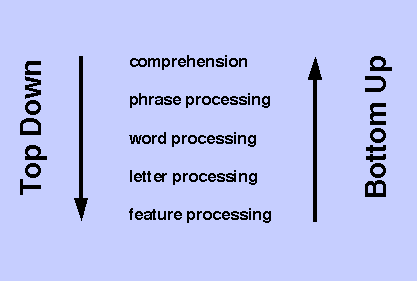
Consequently, the latter use their experience to create a certain context, in which the next portion of the message is going to be perceived (Price & Devlin, 2011). By incorporating the top-down processing strategy into the reading process, a person builds certain expectations for the context of the text that is unwrapping in front of the reader. Indeed, the existing definition of top-down processing as far as reading is concerned mentions the usage of previous experiences to perceive the message behind the text. It should be born in mind, though, that with jumbled words reading, the top-down process becomes not only essential, but also the central process for the reader to focus on. Mentioned in a variety of sources, reading is traditionally defined as a complex cognitive process (Reingold, Reichle, Glaholt & Sheridana, 2013), which means that the top-down process and the interpretation of the meaning of the words is the essential part of reading. Indeed, reading as a phenomenon is quite simple – the decoding of the images on the paper and their further transformation into sounds, as well as the relation of these sounds to specific phenomena and objects that they denote, is a fairly well-known process. The top-down processing of the phrase under consideration, or the recognition of the sensory data acquired from reading the line, may seem quite obvious and not needing an explanation. It would be wrong to claim, though, that the bottom-up processing has no significance in decoding the phrase – quite on the contrary, the given processing stage launches the reader’s ability to think logically and build expectations for the incoming messages. As soon as the reader handles the recognition of these letters, the former is transferred to the next stage of information processing – the interpretation of the initial message and the following development of suppositions regarding the data that will ensue. Hence, the bottom-up processing in a case in point is restricted to the recognition of the fist and the last letter of the words. These pieces of information are crucial for the following analysis of the text and the development of resistance to the mistakes in spelling that the text in question features.


The person reading the text acquires the basic information, which is needed for understanding the text, from the first and the last letter of each word, as the author of the text suggests. The key elements of bottom-up processing can be traced in the specified example quite easily in the course of reading the text provided. In the context of the reading process, the specified element can be defined as the acquisition of sensory information (top-down processing) and the relation of the information acquired (i.e., symbols and letters) to the phenomena and concepts that they denote (Feldman, 2013). In the cognitive perception of information, top-down and bottom-up processing is crucial for successful reading.


 0 kommentar(er)
0 kommentar(er)
